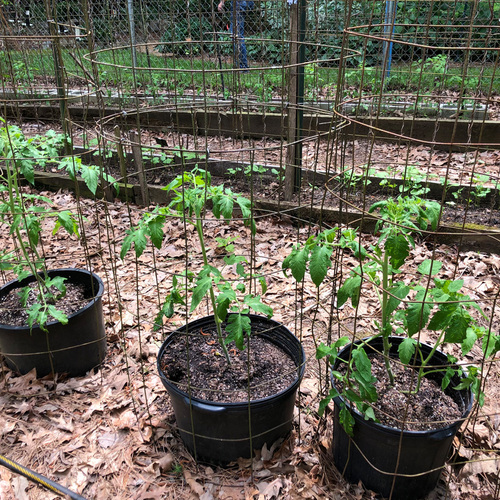Growing tomatoes in containers can yield great results. Container life can also help gardeners overcome some of the challenging conditions of the Southwest, such as low-fertility soils. However, not all tomato varieties are well suited to life in a container. Varieties producing smaller tomatoes tend to perform best, including grape, cherry, sauce, and small-to-medium slicing varieties.
What kind of container do tomatoes grow best in?
In addition to variety selection, container size is an important consideration. Here are some points to remember when choosing a pot to grow tomatoes in:
- A larger container is best. For slicer and sauce tomatoes, select a container that holds at least five gallons of growing media or measures at least 18 inches in diameter and 24 inches deep. Twenty-gallon cloth containers or grow bags work particularly well for tomatoes because the container itself is lightweight. Twenty gallons of media can be rather heavy, and a lightweight cloth container is much easier to handle. Many of the cherry tomatoes featured here can grow in containers smaller than five gallons.
- Tomatoes require consistent moisture to develop healthy fruits and prevent cracking. Larger containers provide more room for root development and retain soil moisture better than small containers.
- Good drainage is also essential. No matter what container you choose, make sure it provides good drainage.
- Select a soilless potting medium designed for containers, as these provide optimal drainage and water-holding capacity without the weight of garden soil.
- Find a sunny spot. Place your containers in a location that receives at least six hours of direct sun per day.
What kind of tomatoes grow best in containers?
Both determinate and indeterminate tomato varieties can be grown in containers. Determinate tomatoes produce all their fruit at once. Plants tend to be more compact, with thicker stems and more branching. Indeterminate varieties produce fruit throughout the entire growing season. They produce larger plants that need sizable containers to support the extensive root system and large vines. Patio, grape, and cherry tomato varieties are well suited to growing in containers.
Great Slicing and Sauce Tomato Varieties for Containers

When growing plants in containers, look for slicing varieties that produce small-to-medium-sized fruits.
- The variety ‘Patio’ is an excellent selection for containers. This dwarf variety displays good disease resistance and grows just 2 feet tall. ‘Patio’ is a determinate variety, producing a heavy crop of 3- to 4-inch fruits.
- Another compact determinate variety, ‘Better Bush’ is a heavy yielder, producing dozens of three-ounce fruits over a two-month harvest period. Plants demonstrate good disease resistance and grow 3 feet tall.
- ‘Celebrity’ is another high-yielding variety for containers. It produces larger, crack-resistant fruits with a sweet and slightly tangy flavor. Plants are known for their excellent disease resistance and are considered semi-determinate. They stop growth at a height of 3 to 4 feet but can produce fruit in all four seasons.
- Many of the thick-walled Roma or sauce-type tomatoes are also well suited to containers. They tend to grow on bush-like plants, most of which are determinate. ‘San Marzano’ is an exception. This indeterminate variety produces heavy fruit loads all season on plants growing up to 4 feet tall. The complex flavor of ‘San Marzano’ tomatoes is prized for making sauces, salsa, and more.
Delicious Cherry Tomato Varieties for Containers
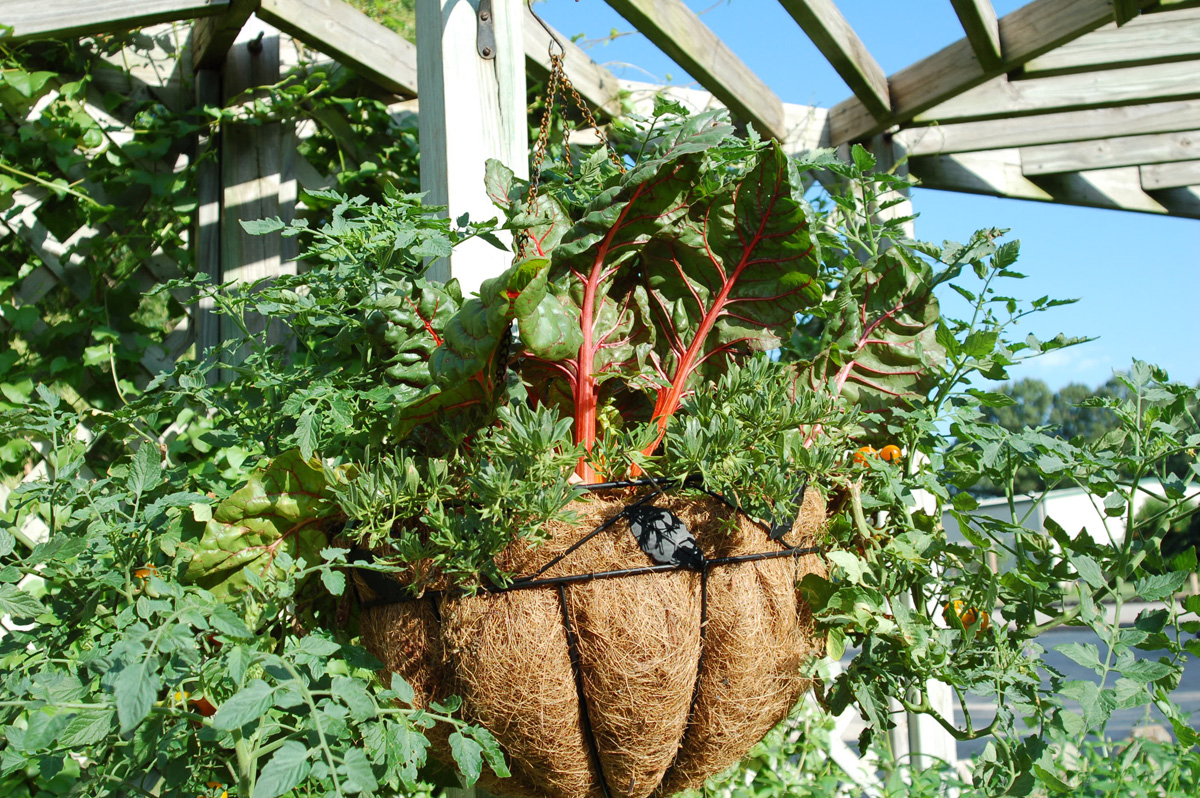
Many cherry tomato varieties thrive in containers, and some have been specifically bred for growing in pots. The selections highlighted here are extremely compact and perform well in containers as small as 12 inches in diameter.
- The aptly named ‘Tiny Tim’ cherry tomato grows just 10 to 12 inches tall. This compact determinate tomato was developed for container life. It produces small, sweet-tart fruits and shows some heat and drought tolerance.
- ‘Tumbler’ is another heavy-producing determinate cherry tomato variety. These compact plants are perfect for hanging baskets, with cascading vines that grow 18 inches long. Plants are very heat tolerant and produce an abundance of sweet, juicy fruits.
- The super sweet ‘Husky Red’ cherry tomato is a dwarf plant with good disease resistance. This is an indeterminate variety perfect for patio pots. It grows a bit larger than the others, reaching 3 to 4 feet tall, but yields all season long on sturdy, attractive plants.
Planting and care tips for growing tomatoes in pots
- Deep planting is best. When planting tomatoes in containers, strive for deep planting to encourage a more robust root system. Remove the lower branches and set plants as deep as possible in their container, up to an inch beneath the uppermost pair of leaves. The buried stem will produce roots that help support the top weight while providing the developing foliage with water and nutrients.
- Most tomatoes benefit from staking. While the diminutive ‘Tiny Tim’ and ‘Tumbler’ tomatoes do not need support, the other tomato varieties listed here will perform well with a cage or other type of staking. Tomato cages are easy to use with containers and are best installed at planting time. Learn about your options for staking tomatoes here.
- Provide container-grown tomatoes with a consistent supply of water. Due to their smaller volume and greater exposure to airflow, pots tend to dry out faster than garden soils. Make sure to irrigate potted tomato plants regularly to maintain even moisture. Avoid fluctuating between wet and dry soil, as this can lead to fruit cracking.
- Potted tomatoes also require regular fertilization. Start by applying a slow-release fertilizer at the time of planting according to label rates, unless the potting medium you are using already contains slow-release fertilizer. After planting, apply a balanced (e.g., 10-10-10), water-soluble fertilizer at two-week intervals until plants flower. Once flowering begins, switch to a high-potassium fertilizer, such as one labeled specifically for tomatoes, continuing applications every two weeks.
Find more information on Southwest gardening here.
To discuss more about growing vegetables in the Southwest or ask other gardening questions, chat with other gardeners in your area on the Gardening Answers forum.
Kim Toscano is a horticulturalist, entomologist, garden designer, writer, and graphic designer. She previously hosted Oklahoma Gardening, a weekly PBS television program produced by the Oklahoma Cooperative Extension Service.
Photos, except where noted: Kim Toscano
Fine Gardening Recommended Products
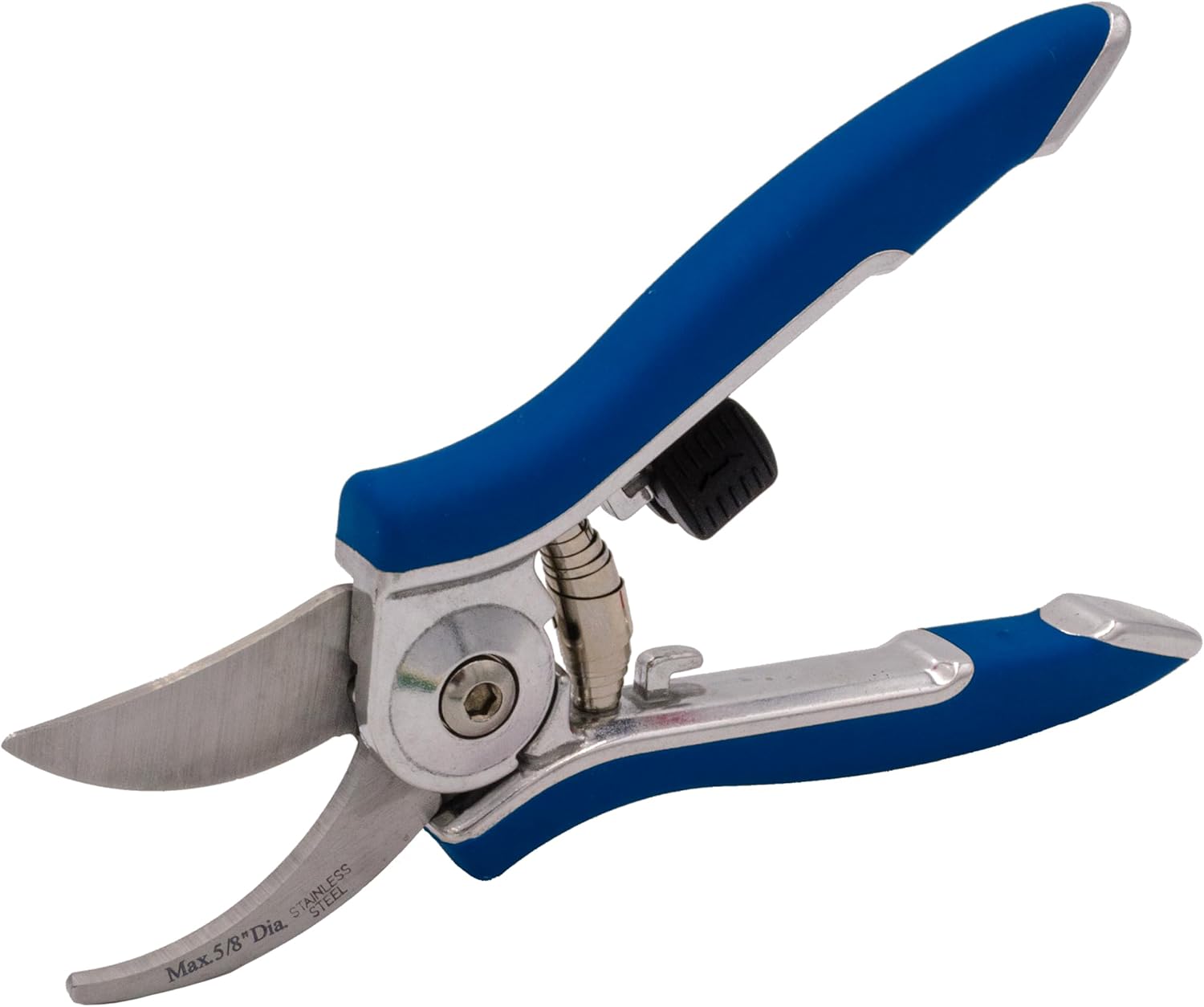
Dramm Bypass Pruner, Cut up to 5/8-inch in diameter, Stainless Steel Blade, Blue
Fine Gardening receives a commission for items purchased through links on this site, including Amazon Associates and other affiliate advertising programs.
Ideal for trimming trees, bushes, and flowers, the Bypass Pruner is designed for both professional and home gardeners. It has a 5/8-inch cutting capacity and is made with corrosion-resistant stainless steel blades for precise cuts. The ergonomic handle and non-slip grip design fit comfortably in your hand. The locking mechanism allows for safe and easy storage. Available in six sharp colors: red, orange, yellow, green, blue, and berry.
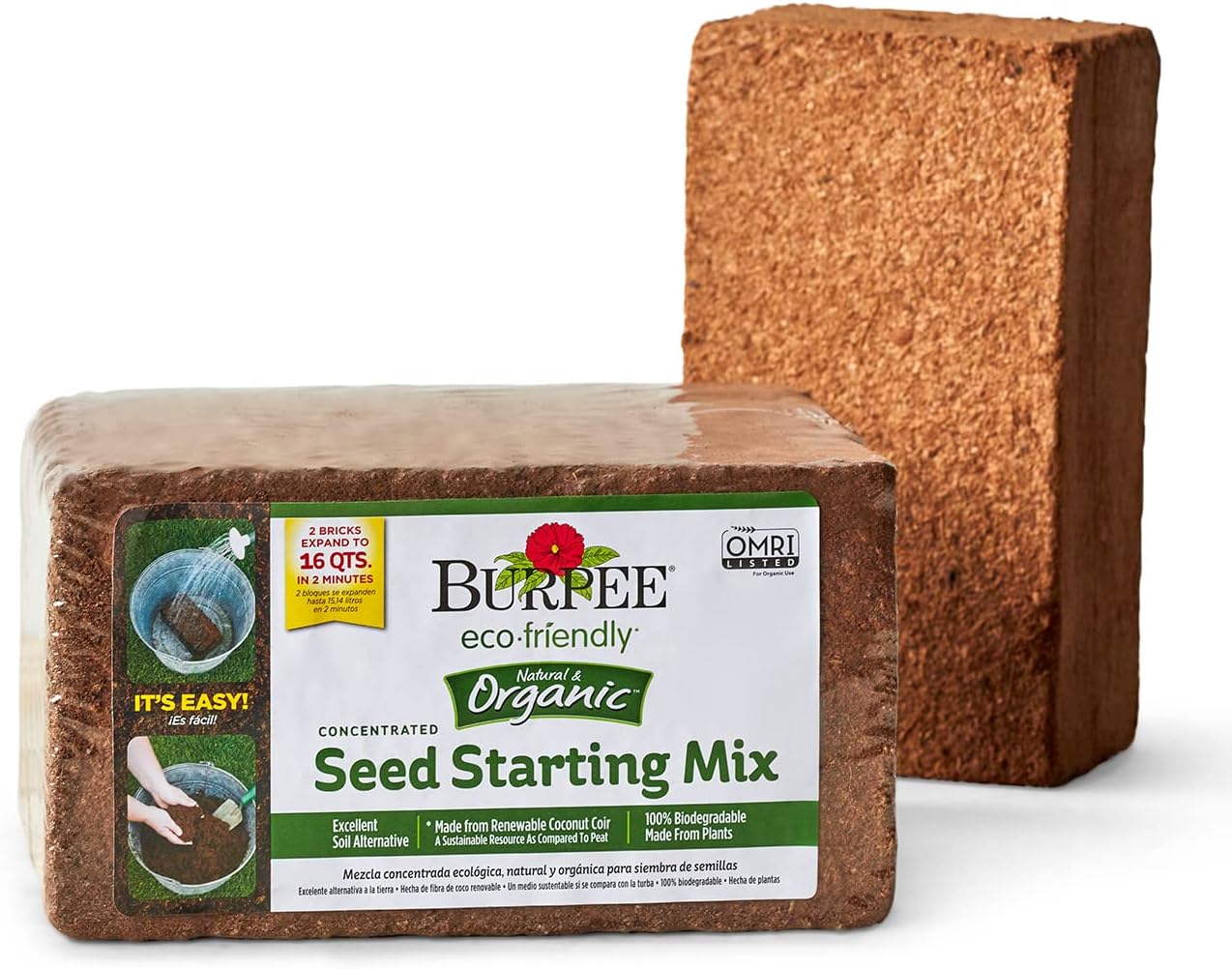
Burpee Organic Coconut Coir Concentrated Seed Starting Mix, 16 Quart
Fine Gardening receives a commission for items purchased through links on this site, including Amazon Associates and other affiliate advertising programs.
ORGANIC COCONUT COIR: Made from recycled coconut husks, coir is a light, sustainable growing medium that holds the perfect amount of moisture for starting seeds. 100% biodegradable soil alternative. Environmentally friendly and a renewable alternative to peat moss. OMRI listed and certified organic. IDEAL GROWING MIX: Improve seed germination and root growth with this premium coconut fiber mix, which improves nutrients absorption! Great for flower, vegetable, herb, and more plant types. OMRI listed. Naturally disease and pathogen resistant, it will help you grow healthy live plants. EASY TO STORE & EXPAND: Each compact coconut coir brick expands into 8 quarts of seed starting mix, providing 16 quarts total. Just add water to expand! Dehydrated bricks save space until planting. Once expanded, coconut coir provides a quality growing medium for all types of plants—indoor plants, house plants, outdoor plants, and more! NATURALLY CONSERVES WATER: Renewable coco coir has excellent moisture retention and better air circulation than peat. This eco-friendly, premium seeds starting mix combines well with other potting soil and compost for container plants & raised beds. 100% GUARANTEED: Burpee is committed to the success of all gardeners. We treat each order with care to ensure healthy seeds, plants, soil mixes, and gardening supplies are sent in excellent condition. If you are unsatisfied with your purchase, we aim to make it right!
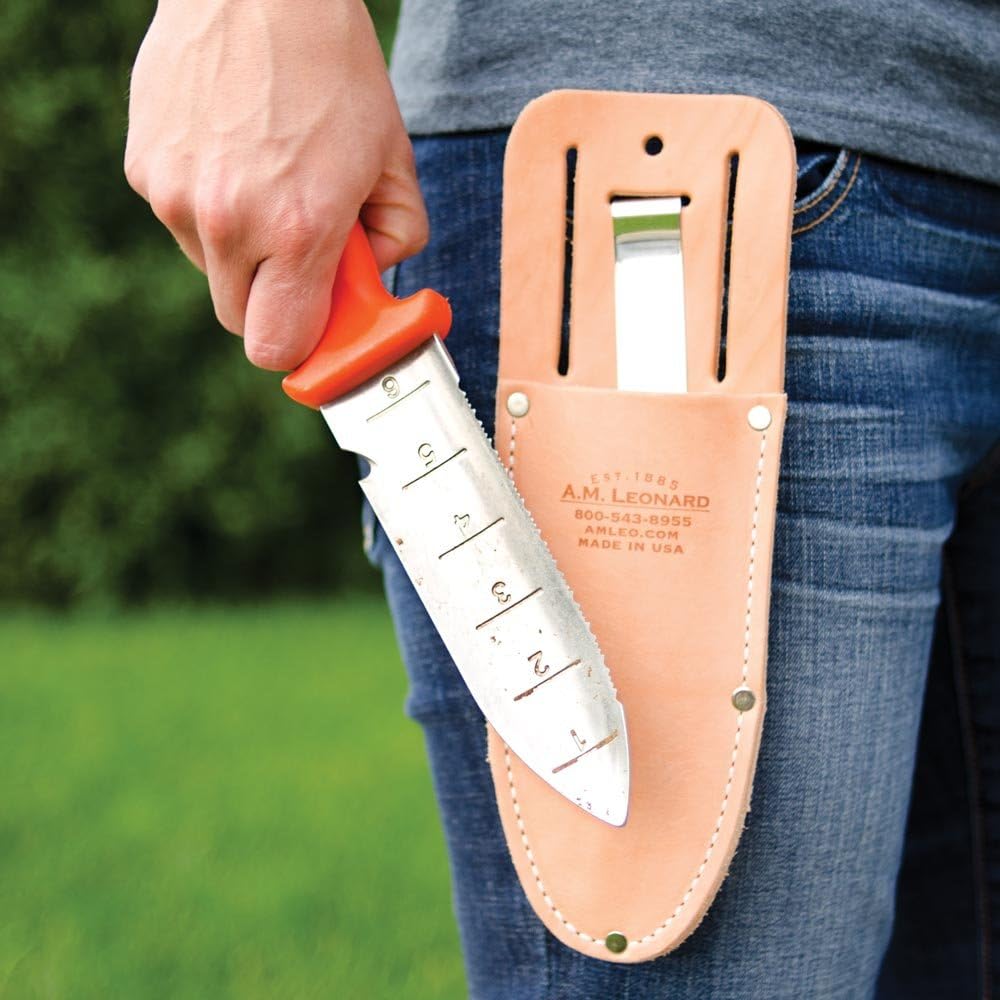
A.M. Leonard Deluxe Soil Knife & Leather Sheath Combo
Fine Gardening receives a commission for items purchased through links on this site, including Amazon Associates and other affiliate advertising programs.
MULTITASKING DUAL EDGES: a deep serrated edge and a tapered slicing edge ideal for tough or delicate cuts. DURABLE 6-inch stainless steel blade withstands 300 lbs of pressure. TWINE CUTTING NOTCH, DEPTH GAUGE MARKINGS & spear point – no need to switch tools when using this garden knife. LEATHER SHEATH: heavy duty, protective, clip on sheath to keep your knife convenient and secure. LIFETIME WARRANTY.

